Atami
Atami (熱海市, Atami-shi) is a city located in Shizuoka Prefecture, Japan. As of 1 May 2019, the city had an estimated population of 36,865 in 21,593 households[1] and a population density of 600 persons per km². The total area of the city is 61.78 square kilometres (23.85 sq mi).
Atami 熱海市 | |
|---|---|
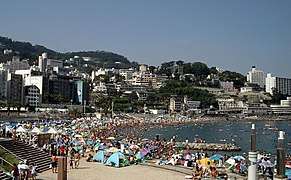 Beach in Atami City with sea bathers | |
 Flag  Emblem | |
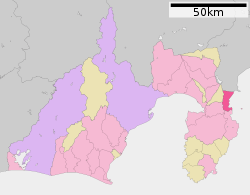 Location of Atami in Shizuoka Prefecture | |
 Atami | |
| Coordinates: 35°05′45.5″N 139°4′17.6″E | |
| Country | Japan |
| Region | Chūbu (Tōkai) |
| Prefecture | Shizuoka |
| Government | |
| • Mayor | Sakae Saitō |
| Area | |
| • Total | 61.78 km2 (23.85 sq mi) |
| Population (May 2019) | |
| • Total | 36,865 |
| • Density | 600/km2 (1,500/sq mi) |
| Time zone | UTC+9 (Japan Standard Time) |
| City symbols | |
| • Tree | Sakura |
| • Flower | Ume |
| • Bird | Common gull |
| Phone number | 0557-86-6000 |
| Address | 1-1 Chūō-chō, Atami-shi, Shizuoka-ken 413-8550 |
| Website | Official website |
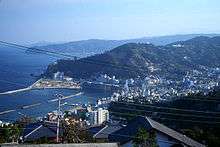
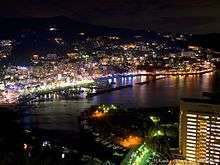
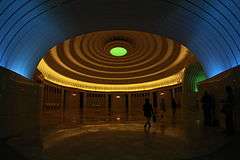
Geography
Atami is located in the far eastern corner of Shizuoka Prefecture at the northern end of Izu Peninsula. The city is on the steep slopes of a partially submerged volcanic caldera on the edge of Sagami Bay. The name "Atami" literally means "hot ocean," a reference to the town's famous onsen hot springs. The city boundaries include the offshore island of Hatsushima. Most of Atami is located within the Fuji-Hakone-Izu National Park. Warmed by the Kuroshio Current offshore, the area is known for its moderate maritime climate with hot, humid summers, and short winters.
Demographics
Per Japanese census data,[2] the population of Atami has been in slow decline over the past 50 years.
| Year | Pop. | ±% |
|---|---|---|
| 1940 | 27,966 | — |
| 1950 | 38,938 | +39.2% |
| 1960 | 52,163 | +34.0% |
| 1970 | 51,281 | −1.7% |
| 1980 | 50,082 | −2.3% |
| 1990 | 47,291 | −5.6% |
| 2000 | 42,936 | −9.2% |
| 2010 | 39,592 | −7.8% |
Climate
The city has a climate characterized by hot and humid summers, and relatively mild winters (Köppen climate classification Cfa). The average annual temperature in Atami is 15.7 °C. The average annual rainfall is 1968 mm with September as the wettest month. The temperatures are highest on average in August, at around 26.3 °C, and lowest in January, at around 6.1 °C.[3]
History
Atami has been known as a resort town centered on its hot springs since the 8th century AD. In the Kamakura period, Minamoto no Yoritomo and Hōjō Masako were notable visitors. During the Edo period, all of Izu Province was tenryō territory under direct control of the Tokugawa shogunate. During the cadastral reform of the early Meiji period in 1889, Atami village was organized within Kamo District, Shizuoka. It was elevated to town status on June 11, 1894, and was transferred to the administrative control of Tagata District in 1896.
The epicenter of the Great Kantō earthquake in 1923 was deep beneath Izu Ōshima Island in Sagami Bay, close to Atami, which suffered considerable damage, as did other municipalities throughout the surrounding Kantō region.[4] The tsunami wave height reached 35 feet at Atami, swamping the town and drowning three hundred people.[5]
The modern city of Atami was founded on April 10, 1937, through the merger of Atami Town with neighboring Taga Village. After the proclamation of Atami as an "International Tourism and Culture City" by the Japanese government in 1950, the area experienced rapid growth in large resort hotel development. This growth increased after Atami station became a stop on the Tōkaidō Shinkansen high-speed train line in 1964. In concert with its famous onsen, Atami was known for its onsen geisha. Atami experienced a considerable decline in popularity as a vacation destination due to the Japanese economic crisis in the 1990s and the associated fall in large group company-sponsored vacations, but is currently experiencing a revival as a commuter town due to its proximity to Tokyo and Yokohama.
The Inagawa-kai, third largest of Japan's Yakuza groups, was founded in Atami in 1949 as the Inagawa-gumi (稲川組) by Kakuji Inagawa.[6]
The Izu Study and Research Center is a study facility of the Japanese Communist Party, where they hold its annual congress.[7]
Government
Atami has a mayor-council form of government with a directly elected mayor and a unicameral city legislature of 15 members.
Economy
The economy of Atami is heavily dependent on the tourist industry, mostly centered on its hot spring resorts.[8] Commercial fishing is a major secondary industry.
Education
Atami has eight public elementary schools and four public junior high schools operated by the city government, and one public high school operated by the Shizuoka Prefectural Board of Education. The International University of Health and Welfare, based in Ōtawara, Tochigi, has a campus in Atami.
International relations
Notable people
- Yū Hayami, singer, actress
- Yuka Imai, voice actress
- Yuji Ohno, jazz musician
- Mitsuko Uchida, classical pianist
Local attractions
- MOA Museum of Art, housing the extensive art collection of eccentric multimillionaire and religious leader Mokichi Okada
- Izusan Jinja, an ancient Shinto shrine
- Peace Pagoda, built by Nipponzan-Myōhōji in 1961.
In popular culture
- In the 1951 film Tokyo File 212, a key scene takes place at a resort in Atami.
- In the 1953 film Tokyo Story the parents visit the hot springs in Atami.
- Much of the 1953 film A Japanese Tragedy is set in Atami.
- Atami is also the setting of the TV drama Atami no Sousakan.
- Atami also appears in the 1954 film "Golden Demon" (Konjiki Yasha), based on the novel of the same name by Kōyō Ozaki, as the place where two main characters become engaged to be married.[11]
- The 1962 film "King Kong vs. Godzilla" has its climactic battle end with the destruction of Atami castle as the two monsters fall into the sea.
- In the 1967 film "Gappa, the Triphibian Monster", the two adult Gappa creatures make landfall in Atami, destroying much of it in the process.
- In the Anime "Only Yesterday" (Ghibli, 1991) the 10 years old main character Taeko did her vacation in Atami, visiting some of the onsen. [12]
- In the 2016 anime Prince of Stride, Atami is the first stop in the End of Summer Trial Tour.[13]
- In the 89th episode of the anime "Urusei Yatsura", Mrs. Moroboshi wins a 2 day trip to Atami with her husband, leaving her son Ataru, the main character, at home alone with Lum.
Notes
- Atami City official statistics (in Japanese)
- Atami population statistics
- Atami climate data
- Hammer, Joshua. (2006). Yokohama Burning: the Deadly 1923 Earthquake and Fire that Helped Forge the Path to World War II, p. 278.
- Hammer, p. 114.
- "1993 Police White Paper Chapter 1 : The Actual Condition of the Boryokudan", 1993, National Police Agency (in Japanese)
- The Mountain Fortress of the Japan Communist Party
- Mansfield, Stephen, "Cultures mingle amid Atami's hot springs", Japan Times, 18 December 2011, p. 12.
- "International Exchange". List of Affiliation Partners within Prefectures. Council of Local Authorities for International Relations (CLAIR). Archived from the original on 13 January 2016. Retrieved 21 November 2015.
- "City of Atami: Mr. Sakae Saito, Mayor (December 2014)". Mayor/Governor Interviews. Foreign Press Center Japan. December 26, 2014. Retrieved 5 January 2016.
- '+relative_time(twitters[i].created_at)+' (2010-04-18). "Odagiri to star in "Atami no Sousakan"". Tokyograph. Retrieved 2013-03-25.
- Nausicaa.net: Synopsis Omohide Poro Poro
- Prince of Stride: Alternative Episode 4 English Sub
References
- Hammer, Joshua. (2006). Yokohama Burning: The Deadly 1923 Earthquake and Fire that Helped Forge the Path to World War II. New York: Simon & Schuster. ISBN 0-7432-6465-7; ISBN 978-0-7432-6465-5 (cloth).
External links
| Wikimedia Commons has media related to Atami, Shizuoka. |

- Official Website (in Japanese)